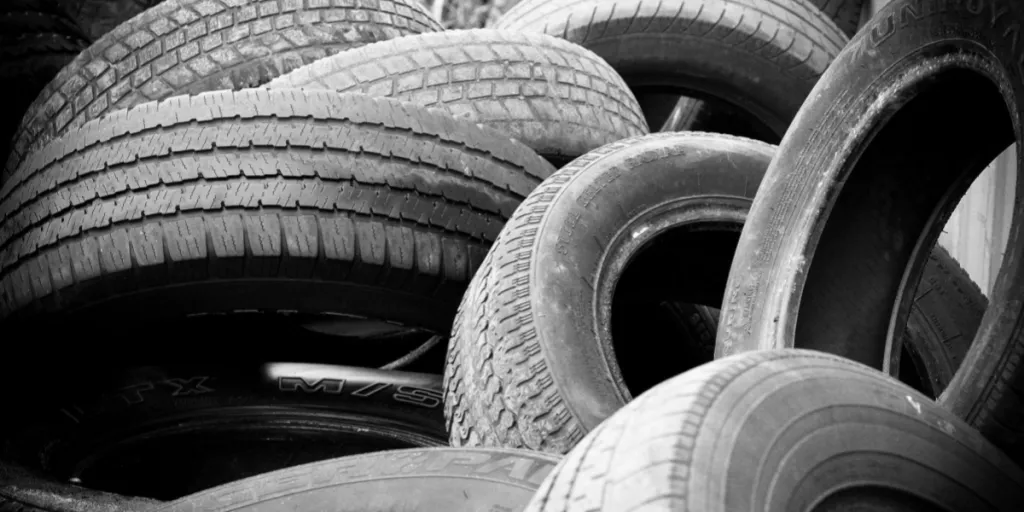Die Reifenindustrie ist in den letzten Jahren immer effizienter und umweltfreundlicher geworden. Da Nachhaltigkeit für Unternehmen weltweit zu einem zentralen Thema wird, entscheiden sich Reifeneinzelhändler und -großhändler für moderne Reifenschneidegeräte, um ihre Betriebsabläufe zu optimieren.
Reifenschneider, auch Reifenschredder oder Reifenrecyclingmaschinen genannt, spielen eine entscheidende Rolle bei der Verarbeitung von Reifen am Ende ihres Lebenszyklus. Sie helfen Unternehmen dabei, dies effizient zu tun und tragen zur Kreislaufwirtschaft.
Dieser Leitfaden führt Großhändler und Reifenhändler durch die Feinheiten des Reifenschneidemarktes, einschließlich der zu beachtenden Merkmale, Sicherheitsfunktionen und Konformität sowie der neuesten Trends bei technisch unterstützten Reifenschneidemaschinen.

Inhaltsverzeichnis
Reifenschneidertypen und -technologien verstehen
Wichtige Faktoren, die bei der Auswahl eines Reifenschneiders zu berücksichtigen sind
Sicherheitsfunktionen und Compliance-Standards
Kosten-Nutzen-Analyse: In die richtige Ausrüstung investieren
Überlegungen zu Wartung und Langlebigkeit
Zukünftige Trends in der Reifenschneidetechnik
Fazit: Eine fundierte Entscheidung treffen
Reifenschneidertypen und -technologien verstehen
A Reifenschneider ist eine Spezialmaschine, die Altreifen in kleinere Stücke schneidet oder zerkleinert und so das Recycling oder die Wiederverwendung erleichtert. Diese Maschinen gibt es in verschiedenen Größen und mit unterschiedlichen Kapazitäten, von kleinen tragbaren Einheiten bis hin zu großen Geräten im industriellen Maßstab. Sie verwenden auch unterschiedliche Schneidmechanismen, wie das Zweigriff-Ventilsystem oder patentierte Scherklingen, und Stromquellen.
Wenn es um Reifenschneider geht, können Unternehmen zwischen mehreren Optionen wählen, die jeweils für unterschiedliche Betriebsanforderungen und Größenordnungen geeignet sind.
Seitenwandfräser
Seitenwandfräser Entfernen Sie die Seitenwände des Reifens und trennen Sie sie von der Lauffläche. Diese eignen sich am besten für Unternehmen, die mit großen Mengen an Reifen von LKWs und landwirtschaftlichen Geräten arbeiten.
Zerkleinerer für ganze Reifen
Diese robuste Maschinen können ganze Reifen verarbeiten und in kleinere Stücke oder Späne zerlegen. Sie sind ideal für Recyclinganlagen oder große Reifenverarbeitungsbetriebe.
Tragbare Reifenschneider
Entwickelt für Mobilität, diese Einheiten eignen sich für Betriebe, die Reifen an verschiedenen Standorten verarbeiten müssen oder nur über begrenzte Platzverhältnisse verfügen. Dies ist eine gute Option, wenn Sie keine eigene Reifenentsorgungsanlage besitzen.
Präzisionsschneider
Präzisionsschneider bieten mehr Kontrolle über den Schneidevorgang. Benutzer können aus den sauber geschnittenen Reifenstücken bestimmte Formen oder Größen erstellen. Bei Herstellungsprozessen, bei denen recyceltes Reifenmaterial verwendet wird, werden diese Schneider häufig verwendet, um eine bessere Kontrolle zu haben.
Hydraulische Reifenschneider
Statt Batterien oder Strom, hydraulische Reifenschneider basieren auf hydraulischer Kraft. Sie erzeugen eine hohe Schneidkraft und sind daher ideal für die Bearbeitung großer oder robuster Reifen.
Wichtige Faktoren, die bei der Auswahl eines Reifenschneiders zu berücksichtigen sind

Die Wahl des richtigen Reifenschneiders erfordert sorgfältige Überlegung. Hier sind einige der wichtigsten Faktoren, die ein Unternehmen bei der Auswahl des richtigen Reifenschneiders für seine Anforderungen berücksichtigen sollte.
Verarbeitungskapazität
Bewerten Sie den aktuellen und geplanten Reifenverarbeitungsbedarf Ihres Unternehmens und die erforderliche Geschwindigkeit. Berücksichtigen Sie die Menge an Reifen, die Sie pro Stunde, Tag oder Woche verarbeiten. Wählen Sie eine Maschine, die diese Kapazität erfüllen oder übertreffen kann.
Verarbeitete Reifentypen
Arbeitet Ihr Unternehmen mit Pkw-Reifen, schwere oder leichte LKW-Reifen oder Spezialreifen irgendeiner Art? Dies bestimmt den Typ des Reifenschneiders, den Sie benötigen, da diese normalerweise für die Verarbeitung bestimmter Reifentypen ausgelegt sind. Beispielsweise könnte ein Reifenschneider für den ganzen Reifen ideal sein, wenn Sie regelmäßig Pkw-Reifen verarbeiten.
Raumbeschränkungen
Wie viel Platz steht Ihnen in Ihrer Einrichtung zur Verfügung? Größere Unternehmen können sich für großformatige Reifenschneider entscheiden, diese benötigen jedoch möglicherweise mehr Platz. Andere sind kompakter und haben häufig eine geringere Kapazität. Wählen Sie eine Maschine, die bequem in Ihren Arbeitsbereich passt, ohne andere Vorgänge zu beeinträchtigen.
Energieeffizienz
Es ist wichtig, einen Reifenschneider zu wählen, der energieeffizient ist. Im Rahmen des größeren Recyclingprozesses ist Nachhaltigkeit ein wichtiger Aspekt und ein Hauptziel. Gleichzeitig senken energieeffiziente Modelle Ihre Verarbeitungskosten aufgrund einer geringeren Stromrechnung.
Automatisierungsstufe
Überlegen Sie, wie viel Automatisierung Ihr Unternehmen benötigt. Natürlich sind vollautomatische Systeme in der Regel effizienter und senken die Arbeits- und Betriebskosten. Allerdings sind ihre Anschaffungskosten deutlich höher. Daher sollten Sie bei der Automatisierung von Reifenschneidern am besten die Gesamtbetriebskosten berücksichtigen.
Geräuschpegel
Reifenschneiden ist oft laut. Wenn Sie für diesen Vorgang eine separate Reifenwerkstatt haben, spielt dies keine große Rolle. Wenn Sie jedoch in einem lärmempfindlichen Gebiet ansässig sind, suchen Sie nach Maschinen mit Geräuschreduzierungsfunktionen.
Staubkontrolle
Beim Reifenschneiden können erhebliche Staubmengen entstehen. Entscheiden Sie sich für Maschinen mit effektiven Staubabsaugsystemen, um eine saubere und sichere Arbeitsumgebung zu gewährleisten.
Sicherheitsfunktionen und Compliance-Standards

Sicherheit ist ein entscheidender Aspekt bei Reifenschneidern. Dies sind Hochleistungsmaschinen, die im Falle eines Unfalls großen Schaden anrichten können. Unabhängig davon, für welchen Reifenschneider Sie sich entscheiden, achten Sie darauf, dass er über die folgenden Sicherheitsfunktionen verfügt.
- Not-Aus-Taster: Der Reifenschneider sollte über einen leicht zugänglichen Not-Aus-Mechanismus verfügen. So können Unfälle vermieden werden.
- Sicherheits Angestellte: Bewegliche Teile sollten durch Schutzvorrichtungen geschützt sein. Sie schützen den Bediener vor möglichen Verletzungen.
- Lockout/Tagout-Systeme: Diese Systeme kommen bei der Wartung oder Reinigung der Maschine zum Einsatz und sorgen dafür, dass diese während des Vorgangs nicht unbeabsichtigt anläuft.
- Schulungsprogramme für Bediener: Einige Hersteller bieten umfassende Schulungsprogramme an, um sicherzustellen, dass Ihr Team die Geräte sicher und effizient bedienen kann.
Darüber hinaus muss der Reifenschneider den relevanten Industrienormen und -vorschriften entsprechen, wie zum Beispiel OSHA-Richtlinien in den Vereinigten Staaten oder CE-Kennzeichnung in Europa.
Kosten-Nutzen-Analyse: In die richtige Ausrüstung investieren

Reifenschneider sind nicht billig. Daher ist es wichtig, die geschäftliche Seite der Investition in einen solchen zu berücksichtigen. Denken Sie an die Anschaffungskosten, die Betriebskosten der Maschine und etwaige Wartungskosten. Insgesamt sollten Sie die Gesamtbetriebskosten eines Reifenschneiders berücksichtigen und nicht nur die Anfangsinvestition.
Die gute Nachricht ist, dass die Investition in den richtigen Reifenschneider langfristig viele Vorteile mit sich bringt. So können Sie sehen, wie sich Ihre Investition auszahlt.
Gesteigerte Effizienz
Ein hochwertiger Reifenschneider kann Ihre Verarbeitungskapazität erheblich steigern, sodass Sie mehr Reifen in kürzerer Zeit bearbeiten können.
Reduzierte Arbeitskosten
Automatisierte oder halbautomatisierte Systeme können den Bedarf an manueller Arbeit verringern und so möglicherweise die Gesamtbetriebskosten senken.
Verbesserte Materialrückgewinnung
Mit modernen Reifenschneidern lassen sich die Reifenbestandteile besser voneinander trennen, was möglicherweise den Wert der wiedergewonnenen Materialien steigert.
Energieeinsparung
Effizientere Maschinen können im Laufe der Zeit zu einem geringeren Energieverbrauch und niedrigeren Betriebskosten führen.
Compliance-Vorteile
Wenn Ihr Unternehmen geeignete Reifenschneidegeräte verwendet, können Sie Umweltvorschriften einhalten. So können Sie möglicherweise Bußgelder oder Strafen vermeiden und gleichzeitig die Attraktivität Ihrer Marke steigern.
Dennoch sollten Sie vor der Anschaffung eines Reifenschneiders eine gründliche Kosten-Nutzen-Analyse durchführen. Berücksichtigen Sie dabei Faktoren wie das geplante Reifenvolumen, Arbeitskosten, Energiekosten und potenzielle Einnahmen aus recycelten Materialien.
Überlegungen zu Wartung und Langlebigkeit
Es gibt mehrere Checklistenpunkte, um die Lebensdauer und Leistung Ihres Reifenschneiders zu maximieren.
- Regelmäßiger Wartungsplan: Wählen Sie eine Maschine mit klaren Richtlinien und geringem Wartungsaufwand und halten Sie sich an den empfohlenen Zeitplan.
- Ersatzteilverfügbarkeit: Stellen Sie sicher, dass es einfach ist, Ersatzwerkzeuge und -teile zu bekommen, falls etwas kaputt geht. Prüfen Sie, ob die Kosten nicht zu hoch sind.
- Garantie- und Serviceunterstützung: Suchen Sie nach Herstellern, die umfassende Garantien und zuverlässigen Servicesupport über möglichst viele Jahre hinweg bieten.
- Reinigung: Minimieren Sie die Ausfallzeiten Ihrer Produkte, indem Sie ein Modell wählen, das leicht zu reinigen und zu warten ist.
- Haltbarkeit der Schneidklingen: Berücksichtigen Sie die Lebensdauer der Klingen und wie einfach sie auszutauschen sind.
Zukünftige Trends in der Reifenschneidetechnik

Neben dem, was traditionell auf dem Markt erhältlich ist, können zukunftsorientierte Unternehmen einige der Toptrends und Technologien im Bereich der elektrischen Reifenschneider in Betracht ziehen.
Mit dem fortschreitenden technologischen Fortschritt bestimmen mehrere Trends die Zukunft der Reifenschneideausrüstung.
IoT-Integration
Wie die meisten intelligenten Geräte kommen auch intelligente Reifenschneider auf den Markt. Sie sind mit Internet of Things (IoT)-Funktionen ausgestattet, sodass Sie sie in Echtzeit überwachen und warten können. Sie können auch mit anderen Prozessen in Ihrer Anlage verknüpft werden.
Künstliche Intelligenz
KI-gestützte Systeme können Schnittmuster optimieren und die Materialrückgewinnungsraten verbessern. Im Wesentlichen erarbeiten sie den bestmöglichen Plan zum Reifenschneiden auf der Grundlage Ihrer Ziele, die beispielsweise eine höhere Effizienz, ein geringerer Energieverbrauch, eine höhere Automatisierung usw. sein können.
Nachhaltige Energiequellen
Einige Hersteller testen solarbetriebene oder hybride Reifenschneidesysteme, um die Umweltbelastung zu reduzieren. Reifenschneidesysteme sind ein wichtiger Bestandteil des Recyclingprozesses, daher können diese Systeme die Nachhaltigkeitsziele Ihres Unternehmens fördern.
Fortschrittliche Materialtrennung
Es entstehen neue Technologien, um verschiedene Reifenkomponenten, darunter Gummi, Stahl und Textilmaterialien, besser zu trennen und zurückzugewinnen. Dies kann zu höheren Einnahmen durch den Weiterverkauf dieser Materialien führen und die Nachhaltigkeit ihres Recyclings erhöhen.
Kompakte Modelle mit hoher Kapazität
Innovative Designs führen zu kompakteren Reifenschneidern, die dennoch hohe Kapazitäten verarbeiten können. Diese eignen sich hervorragend für Unternehmen mit Platzbeschränkungen, sind derzeit jedoch mit hohen Kosten verbunden.
Fazit: Eine fundierte Entscheidung treffen
Wenn Sie einen Reifenschneider kaufen möchten, ist die Auswahl des richtigen Modells entscheidend. Das richtige Modell kann die Effizienz und Rentabilität steigern und gleichzeitig Ihren ökologischen Fußabdruck verringern. Ein schlecht gewähltes Modell hingegen wird Ihre Anfangsinvestition auffressen, ohne die gewünschten Ergebnisse zu erzielen.
Daher sollten Unternehmen mehrere Faktoren sorgfältig berücksichtigen:
- Ihre Verarbeitungsbedürfnisse
- Verfügbarer Platz
- Zu recycelnde Reifentypen
- Sicherheit und andere Funktionen
- Kosten-Nutzen-Analyse
- Zukunftstrends
Auf der Grundlage dieser Faktoren kann Ihr Unternehmen eine fundierte Entscheidung treffen, die seinen Zielen und betrieblichen Anforderungen entspricht.





 Afrikaans
Afrikaans አማርኛ
አማርኛ العربية
العربية বাংলা
বাংলা Nederlands
Nederlands English
English Français
Français Deutsch
Deutsch हिन्दी
हिन्दी Bahasa Indonesia
Bahasa Indonesia Italiano
Italiano 日本語
日本語 한국어
한국어 Bahasa Melayu
Bahasa Melayu മലയാളം
മലയാളം پښتو
پښتو فارسی
فارسی Polski
Polski Português
Português Русский
Русский Español
Español Kiswahili
Kiswahili ไทย
ไทย Türkçe
Türkçe اردو
اردو Tiếng Việt
Tiếng Việt isiXhosa
isiXhosa Zulu
Zulu